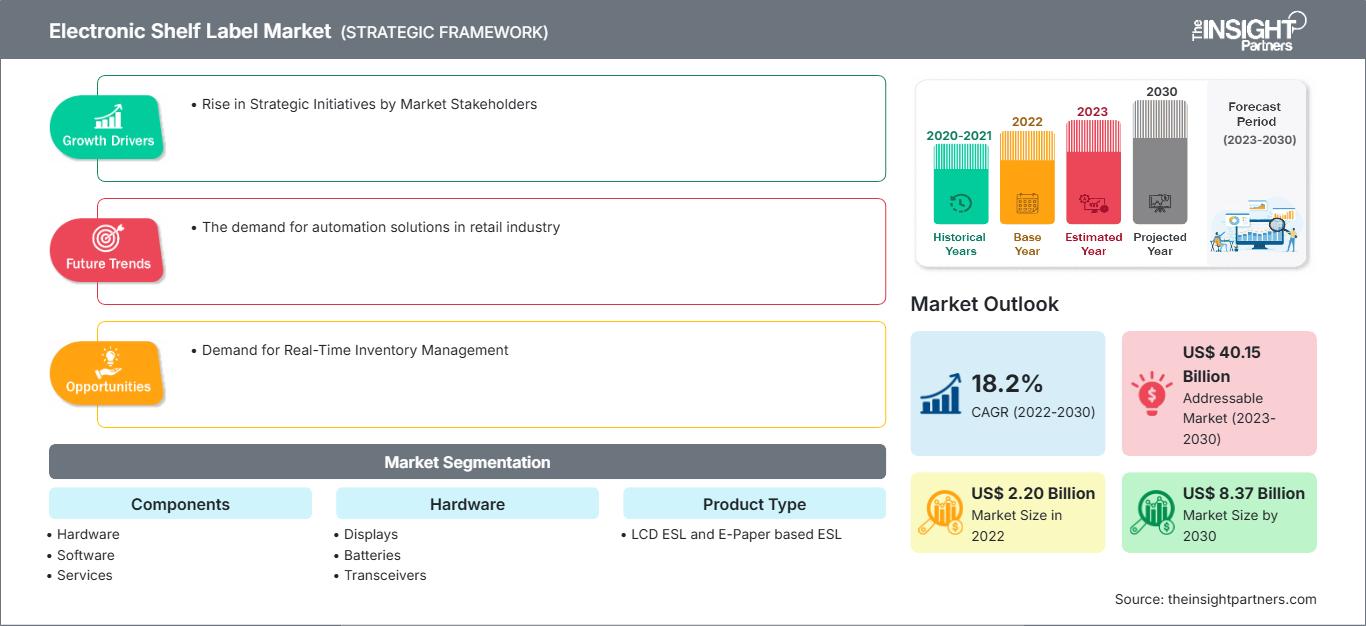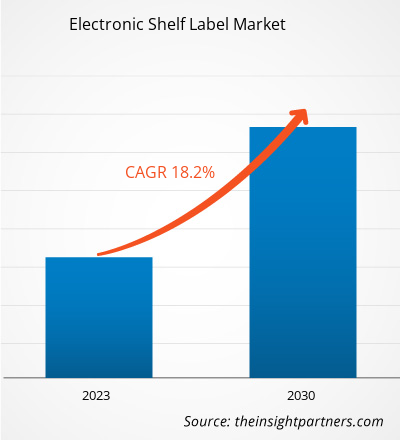电子货架标签市场规模预计将从 2022 年的 22 亿美元增至 2030 年的 83.7 亿美元。预计 2022 年至 2030 年期间的复合年增长率为 18.2%。零售业对自动化解决方案的需求可能仍将是市场的主要趋势。
电子货架标签市场分析
超市、商场和商店数量的增加、劳动力可用性的减少以及零售自动化需求的趋势等因素正在影响电子货架标签市场的增长。然而,该系统所需的高昂安装费用和支持基础设施是制约电子货架标签市场增长的关键挑战。此外,世界正在朝着数字化的方向发展。由于 ESL 系统维护成本低,零售业正在广泛采用该系统,因为它为零售商带来了好处。这为电子货架标签系统市场的市场参与者创造了巨大的机会。此外,工业4.0的融合以及ESL先进技术的出现,例如多色电子纸和免电池解决方案,预计将对电子货架标签市场产生积极影响。
电子货架标签市场概览
零售商使用电子货架标签系统在货架上显示产品价格。该系统正日益普及,因为它具有诸多优势,例如,每当中央控制服务器更改价格时,产品价格就会自动更新。超市、专卖店和大型超市数量的不断增长,也推动了电子货架标签市场的需求。美国、中国、法国、德国和日本是电子货架标签市场收入份额最高的五个主要国家。
自定义此报告以满足您的要求
您将免费获得任何报告的定制,包括本报告的部分内容,或国家级分析、Excel 数据包,以及为初创企业和大学提供超值优惠和折扣
电子货架标签市场: 战略洞察

-
获取本报告的主要市场趋势。这个免费样本将包括数据分析,从市场趋势到估计和预测。
电子货架标签市场驱动因素和机遇
市场利益相关者采取更多战略举措以利于市场发展
零售行业的自动化通过减少人为错误,使大量零售商受益。此外,全球零售业正在持续增长。例如,根据美国政府的数据,美国零售额从 2019 年的 54,023 亿美元增长 3.1% 至 2020 年的 55,704 亿美元。根据印度品牌资产基金会的数据,预计到 2032 年印度零售业的价值将达到 2 万亿美元。零售业越来越重视通过消除商店中与库存、更改价格等相关的手动操作来降低总运营成本。因此,整个零售业对自动化解决方案的需求正在上升。此外,自动化概念还包括在零售店中使用电子货架标签 (ESL),以最大程度地减少手动任务,从而有助于降低管理费用。
电子货架标签 (ESL) 市场的参与者正在推出 ESL,以满足日益增长的零售产品需求。以下提到了一些增长策略。
- 2023 年 1 月,Ynvisible Interactive Inc. 为杂货店零售商推出了一款大幅面电子货架标签显示器。
- 2023 年 5 月,Pricer & StrongPoint 推出了可以显示黄、红、黑、白图形的电子货架标签。高分辨率图形和鲜艳色彩的使用吸引了更多顾客,并提高了商店销售额。
因此,市场参与者的此类战略举措推动了电子货架标签市场的增长。
对实时库存管理的需求
对实时库存管理解决方案的需求增加了企业对电子货架标签的需求。传统的纸质标签无法为企业提供准确及时的库存信息。这可能会导致缺货产品被错误地显示为有货等问题,从而进一步引起客户不满并降低企业销售额。电子货架标签可以整合到零售商的库存管理系统中,提供实时的库存更新。这使得店员能够快速便捷地检测出何时需要补货,确保客户不会因为缺货而感到失望。
电子货架标签市场报告细分分析
促成电子货架标签市场分析的关键细分领域包括组件、硬件、产品类型、商店类型和通信技术。
- 根据组件,电子货架标签市场分为硬件、软件和服务。硬件领域在2022年占据了更大的市场份额。
- 根据硬件,市场细分为显示器、电池、收发器、微处理器等。预计显示部分将在预测期内增长。
- 就产品类型而言,电子货架标签市场分为液晶 ESL 和基于电子纸的 ESL。预计基于电子纸的 ESL 部分将在预测期内增长。
- 根据商店类型,市场分为大卖场、超市、非食品零售店、专卖店和其他。预计大卖场部分将在预测期内增长。
- 根据通信技术,市场分为射频、红外、近场通信和其他。射频部分在 2022 年占据了更大的市场份额。
按地区划分的电子货架标签市场份额分析
电子货架标签市场报告的地理范围主要分为五个地区:北美、亚太地区、欧洲、中东和非洲以及南非。中美洲。
北美工业制冷设备市场分为美国、加拿大和墨西哥。北美电子货架标签市场受到零售店数量庞大和零售业蓬勃发展的推动。该地区汇聚了全球大多数大型零售商。加拿大和墨西哥拥有各自最大的零售连锁店,并且两国都有在全球开展业务的零售公司。零售业占美国GDP的近三分之二。美国主要的零售连锁店包括沃尔玛、艾伯森公司、CVS Health、亚马逊、沃尔格林博姿联盟、好市多、克罗格公司和塔吉特。
电子货架标签市场
The Insight Partners 的分析师已详尽阐述了预测期内影响电子货架标签市场的区域趋势和因素。本节还讨论了北美、欧洲、亚太地区、中东和非洲以及南美和中美洲的电子货架标签市场细分和地域分布。
电子货架标签市场报告范围
| 报告属性 | 细节 |
|---|---|
| 市场规模 2022 | US$ 2.20 Billion |
| 市场规模 2030 | US$ 8.37 Billion |
| 全球复合年增长率 (2022 - 2030) | 18.2% |
| 历史数据 | 2020-2021 |
| 预测期 | 2023-2030 |
| 涵盖的领域 |
By 组件
|
| 覆盖地区和国家 |
北美
|
| 市场领导者和主要公司简介 |
|
电子货架标签市场参与者密度:了解其对业务动态的影响
电子货架标签市场正在快速增长,这得益于终端用户需求的不断增长,而这些需求的驱动因素包括消费者偏好的不断变化、技术进步以及对产品优势的认知度不断提高。随着需求的增长,企业正在扩展产品线,不断创新以满足消费者需求,并抓住新兴趋势,从而进一步推动市场增长。

- 获取 电子货架标签市场 主要参与者概述
电子货架标签市场新闻及最新动态
电子货架标签市场的评估是通过收集一手和二手研究后的定性和定量数据进行的,这些数据包括重要的企业出版物、协会数据和数据库。以下列出了电子货架标签市场的一些发展:
- 汉朔科技在中国重庆国际博览中心举办了“焕新卓越”新品发布会,正式发布了四色星云系列电子货架标签 (ESL)。(来源:汉朔科技,公司网站,2023 年 4 月)
电子货架标签市场报告内容及交付成果
《电子货架标签市场规模及预测(2020-2030)》报告对市场进行了详细的分析,涵盖以下领域:
- 电子货架标签市场规模以及涵盖范围内所有关键细分市场的全球、区域和国家/地区预测
- 电子货架标签市场趋势以及市场动态,例如驱动因素、限制因素和关键机遇
- 详细的 PEST/Porter 五力模型和 SWOT 分析
- 电子货架标签市场分析,涵盖关键市场趋势、全球和区域框架、主要参与者、法规和最新市场发展
- 行业格局和竞争分析,涵盖市场集中度、热图分析、知名参与者和电子货架标签市场的最新发展
- 详细的公司简介
- 历史分析(2 年)、基准年、预测(7 年)及复合年增长率
- PEST和SWOT分析
- 市场规模、价值/数量 - 全球、区域、国家
- 行业和竞争格局
- Excel 数据集
近期报告
相关报告
客户评价
购买理由
- 明智的决策
- 了解市场动态
- 竞争分析
- 客户洞察
- 市场预测
- 风险规避
- 战略规划
- 投资论证
- 识别新兴市场
- 优化营销策略
- 提升运营效率
- 顺应监管趋势






















 获取免费样品 - 电子货架标签市场
获取免费样品 - 电子货架标签市场